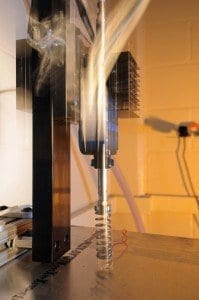
“If we time things right, the robot can jump with a tenth of the power required to jump to the same height under other conditions,”
A new study shows that jumping can be much more complicated than it might seem. In research that could extend the range of future rescue and exploration robots, scientists have found that hopping robots could dramatically reduce the amount of energy they use by adopting a unique two-part “stutter jump.”
Taking a short hop before a big jump could allow spring-based “pogo-stick” robots to reduce their power consumption as much as ten-fold. The formula for the two-part jump was discovered by analyzing nearly 20,000 jumps made by a simple laboratory robot under a wide range of conditions.
“If we time things right, the robot can jump with a tenth of the power required to jump to the same height under other conditions,” saidDaniel Goldman, an assistant professor in theSchool of Physics at the Georgia Institute of Technology. “In the stutter jumps, we can move the mass at a lower frequency to get off the ground. We achieve the same takeoff velocity as a conventional jump, but it is developed over a longer period of time with much less power.”
The research was reported October 26 in the journal Physical Review Letters. The work was supported by the Army Research Laboratory’s MAST program, the Army Research Office, the National Science Foundation, the Burroughs Wellcome Fund and the GEM Fellowship.
Jumping is an important means of locomotion for animals, and could be important to future generations of robots. Jumping has been extensively studied in biological organisms, which use stretched tendons to store energy.
The Georgia Tech research into robot jumping began with a goal of learning how hopping robots would interact with complicated surfaces – such as sand, granular materials or debris from a disaster. Goldman quickly realized he’d need to know more about the physics of jumping to separate the surface issues from the factors controlled by the dynamics of jumping.
Inspired by student-directed experiments on the dynamics of hopping in his nonlinear dynamics and chaos class, Goldman asked Jeffrey Aguilar, a graduate student in the George W. Woodruff School of Mechanical Engineering, to construct the simplest jumping robot. Aguilar built a one-kilogram robot that is composed of a spring beneath a mass capable of moving up and down on a thrust rod. Aguilar used computer controls to vary the starting position of the mass on the rod, the amplitude of the motion, the pattern of movement and the frequency of movement applied by an actuator built into the robot’s mass. A high-speed camera and a contact sensor measured and recorded the height of each jump.
via Georgia Tech
The Latest Streaming News: Hopping Robots updated minute-by-minute
Bookmark this page and come back often
Latest NEWS
Latest VIDEO









